What is Salesforce CDP?
Learn what Salesforce CDP is, how it works, and the key features within the platform.
Luke Kline
November 13, 2023
|13 minutes

There are more customer data platforms available on the market than ever before. At some point or another, it feels like every SaaS company inevitably becomes a Customer Data Platform. The most recent company to pivot into the enterprise CDP space is Salesforce.
This blog post will cover:
- What is a CDP?
- How Salesforce CDP works
- Core products and capabilities
- Key features like data collection, storage, modeling, and audience management
- Real-time capabilities
- Integrations
- Security
- Pricing
- Use Cases
- Pros/Cons
What is a CDP?
A Customer Data Platform (CDP) is a centralized marketing platform that allows you to collect behavioral data, build audiences, and sync that data to your downstream operational tools for marketing activation.
The entire purpose of a CDP is to provide you with a centralized platform where you can manage and manipulate your customer data so your marketing team can leverage that information to build personalized experiences for your customers. In most cases, the main use cases for CDPs are focused on improving audience targeting and audience reach across channels and digital touchpoints.
Salesforce CDP Quick Guide
Don’t have time to read our blog post? Download this one-pager on Salesforce CDP for the key information.


What is Salesforce CDP
Salesforce CDP is a traditional CDP offering that helps you consolidate customer data across your many different Salesforce organizations, like sales, service, commerce, marketing, etc., into a single unified customer profile so you can build audience cohorts for marketing activation.
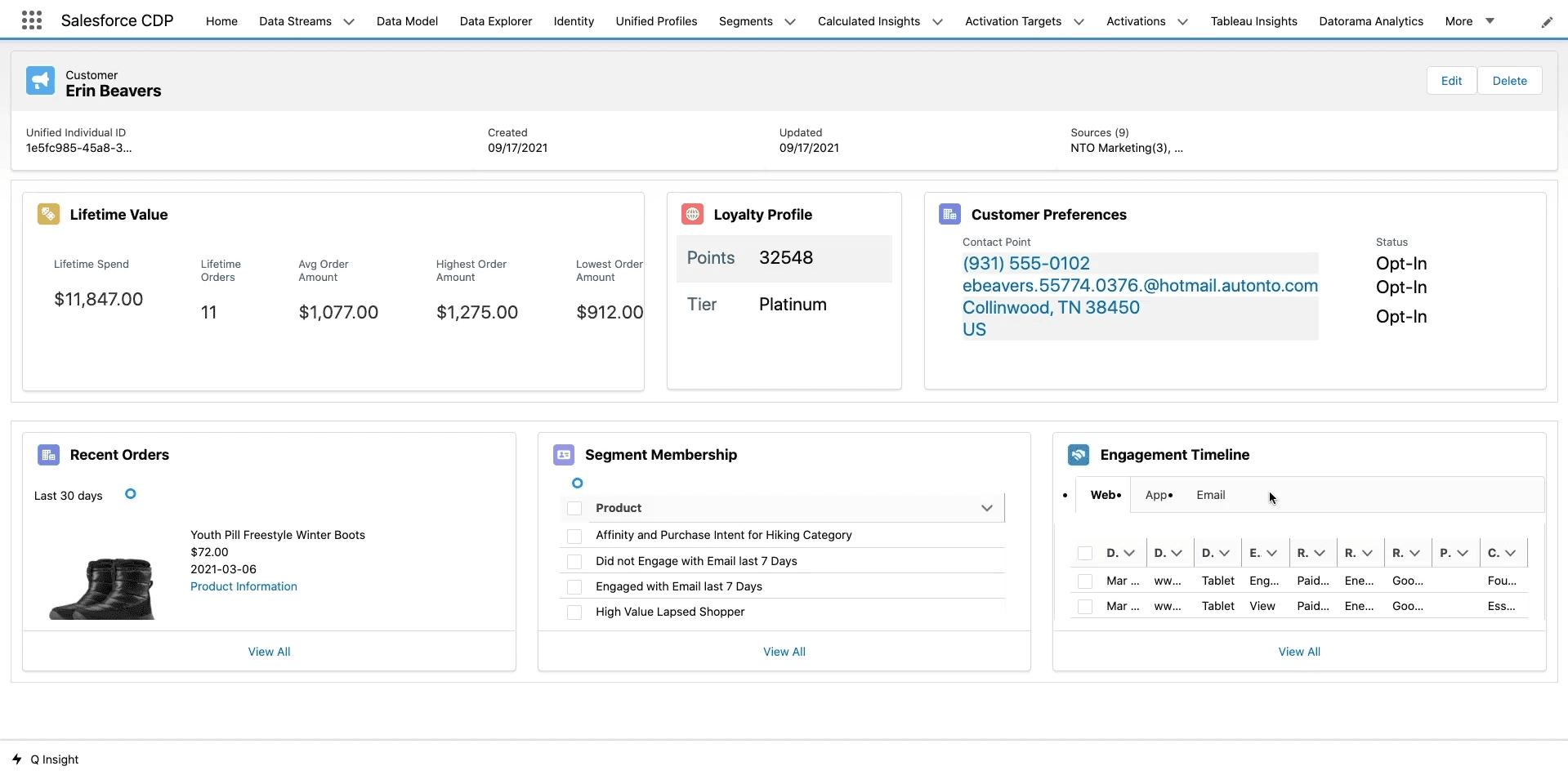
Overview of Salesforce CDP
Given that Salesforce is best known as a customer relationship management platform, the company’s CDP offering is actually more of a marketing repositioning statement rather than an entirely new product. Most of the features and capabilities that make up Salesforce CDP already existed before this platform launched. Salesforce just repackaged them underneath this term to tap into the billion-dollar industry of customer data platforms.
The product is part of the Salesforce Marketing Cloud (SFMC) suite and is focused on unification and segmentation. Under the hood, the Salesforce CDP is powered by Salesforce Genie, which is a data lake that underpins the entire Salesforce ecosystem. Genie is a fully managed data platform built on top of AWS products like EMR, S3, DynamoDB, etc.
Traditional CDP vs. Composable CDP
See how the two approaches compare across speed, compliance, cost, and scale—all in one chart.


Core Products and Capabilities
While Salesforce provides a number of features and capabilities, Salesforce CDP is explicitly focused on managing your customer data to empower your marketing teams. The platform is made up of four core components.
- Data collection: collecting behavioral events from other Salesforce workspaces and various data sources like websites, mobile apps, or cloud storage.
- Identity resolution: Stitching together behavioral events into unified customer profiles.
- Audience management: Segmenting granular audience cohorts by attributes and events that you define.
- Activation: Syncing audience segments and events to downstream destinations.
One important factor to keep in mind is that all of these features come bundled together, which can make the platform inaccessible for any company not bought into the entire Salesforce ecosystem. This is one of the core reasons that many companies are choosing to adopt modern alternatives like Composable CDPs instead.
Data Collection
All data collection into Salesforce CDP is powered by a feature called data streams. Data streams are pipelines that let you automatically ingest data from various sources directly into the platform. Within the data streams tab, you can set up connections for various sources, including:
- Marketing Cloud
- Salesforce CRM
- Commerce Cloud
- Mobile App
- Website
- Ingestion API
- Interaction Studio
- Mulesoft
- Cloud Storage (AWS S3, Google Cloud Storage)
For event tracking, Salesforce CDP offers software development kits (SDKs) for web, mobile, and server-side tracking. Embedding this code directly in your applications, you can collect behavioral data like page views, button clicks, or other clickstream data that you define.
One of the major downsides of Salesforce CDP is the fact that the platform is largely designed to collect and ingest data from other Salesforce organizations. The platform itself doesn’t natively have access to other external data sources like your data warehouse, which houses other offline data, first-party attributes, and data science models. Ultimately, this means your understanding of the customer is limited to the events you capture and the data stored within your other Salesforce Organizations.
Data Storage
From a data storage standpoint, all of your data is stored within the Salesforce infrastructure. Any events you collect via Salesforce SDKs are automatically ingested and stored within Salesforce CDP. Likewise, any audience segments you build or publish also live within Salesforce CDP. This can introduce some serious vendor-lock-in because you have no ability to access additional information outside of Salesforce. Additionally, you’re at the mercy of the platform for how long you can actually store events and audiences.
Data Modeling
Because data streams ingest your data “as is” without any transformation, Salesforce has a visual UI that lets you transform, filter, and join your data using workflows with various dependencies. You can run transformation jobs in real-time or via batches and save transformations as recipes for future use.
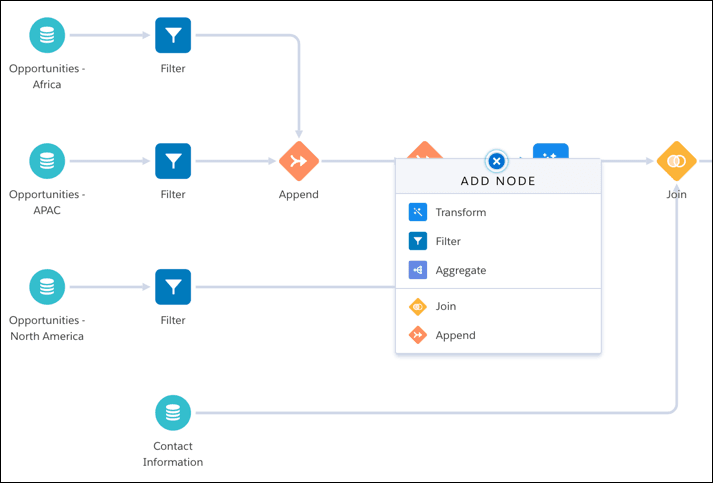
Data Modeling in Salesforce
One of the major downsides to this data modeling approach is that you inevitably end up managing and maintaining complicated workflows that have to be rebuilt from the ground up anytime you want to add an additional attribute or dataset. Any mature organization would never perform transformations or joins on their data in a CRM. These types of use cases should always take place in your data warehouse because it’s much easier to standardize, observe, and maintain those processes in code rather than workflows.
Schema Management
Any data you ingest into Salesforce has to conform to the platform’s schema, and before you can actually leverage any of your data, you first have to map the objects from your data streams to a data model in Salesforce CDP. One of the problems here lies in the fact that Salesforce only supports 50 data models under the standard customer 360 data model that the platform offers.
To make matters worse, all objects within Salesforce CDP need to map back to an individual; otherwise, the profile unification will be inaccurate. This linkage is powered by a complex customer graph that you must apply to all your data models. The mapping works left to right with data source objects (DSOs) on the left and data model objects (DMOs) on the right.

Schema Management in Salesforce
If you have complex use cases where you need to support other custom entities and objects like households, workspaces, playlists, subscriptions, etc., this can be very challenging.
Identity Resolution
Salesforce CDP has an identity resolution feature to help you match and link multiple sources of data into a single cohesive customer identity. Once your profiles have been stitched together, you can view all of your users in a dashboard that provides a unified view of each customer, and you can even search for contacts using specific fields that you define.
One of the major downsides to identity resolution in Salesforce CDP is that you can only match on identifiers that exist within your Salesforce ecosystem (e.g., Service Cloud ID, Marketing Cloud Subscriber Key, Web Cookie, etc.)
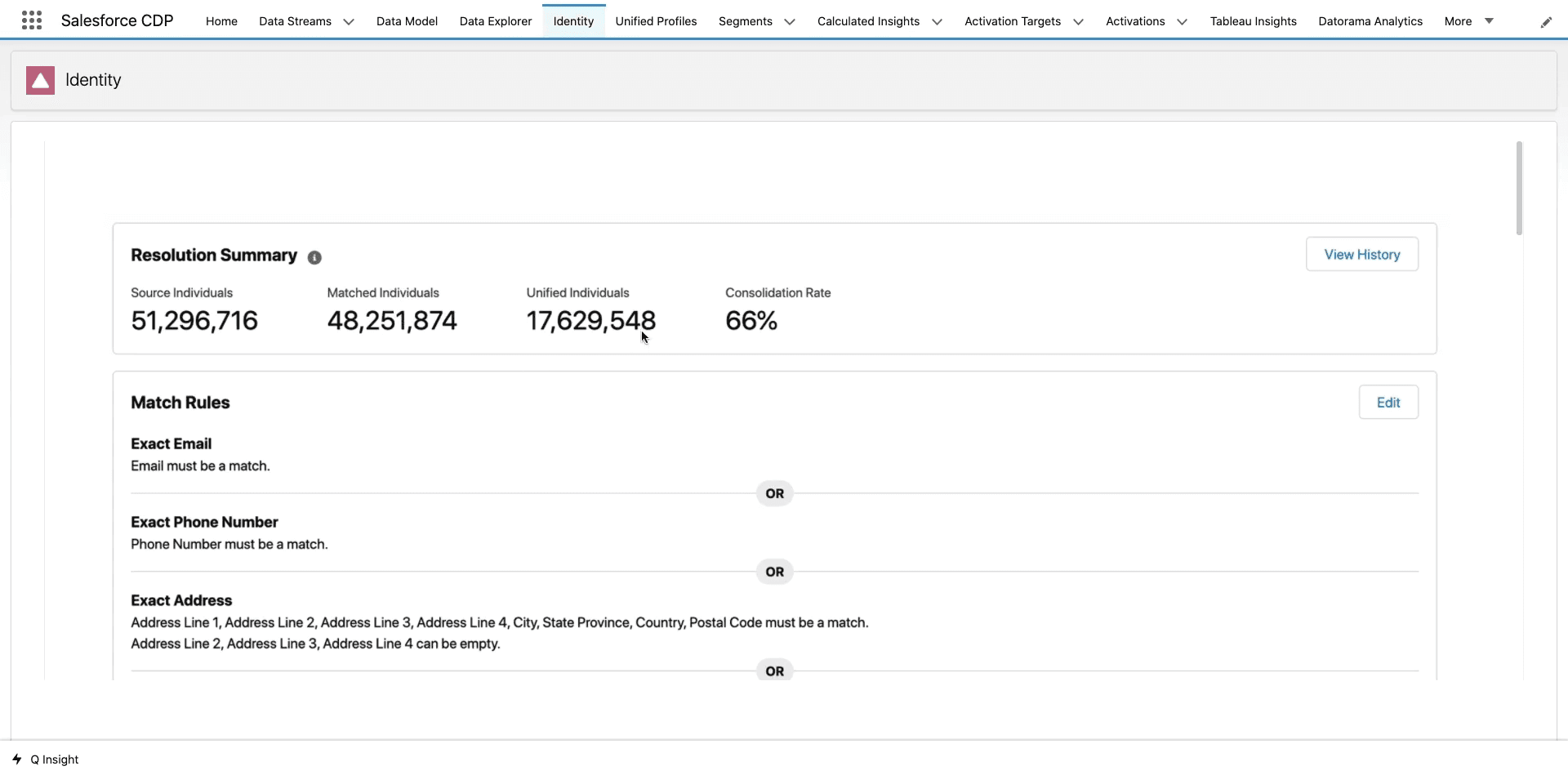
Identity Resolution Matching Logic
Additionally, the identity resolution algorithm is locked into the Salesforce ecosystem, which makes it very difficult to adjust around your specific use cases. The platform provides default matching algorithms you can leverage to combine profiles. For more complex use cases, you have to ensure your data is modeled properly within Salesforce CDP, which can be problematic given that the platform is not nearly as flexible as a data warehouse where you can easily transform and manipulate your data.

Identity Resolution View
Audience Management
Within Salesforce CDP, you have access to an audience builder that lets you break down your data into specific segments so you can target and analyze particular customers or user cohorts. Keep in mind that audiences are solely limited to users and accounts. The platform does not support other custom entities or objects out of the box, and doing so will require quite a bit of work on your part.
Once you publish a segment or audience, Salesforce CDP automatically stores information about the members of that segment. Within the segments tab in Salesforce CDP, you can see your different audience cohorts and other important details like the total population and the publish status.
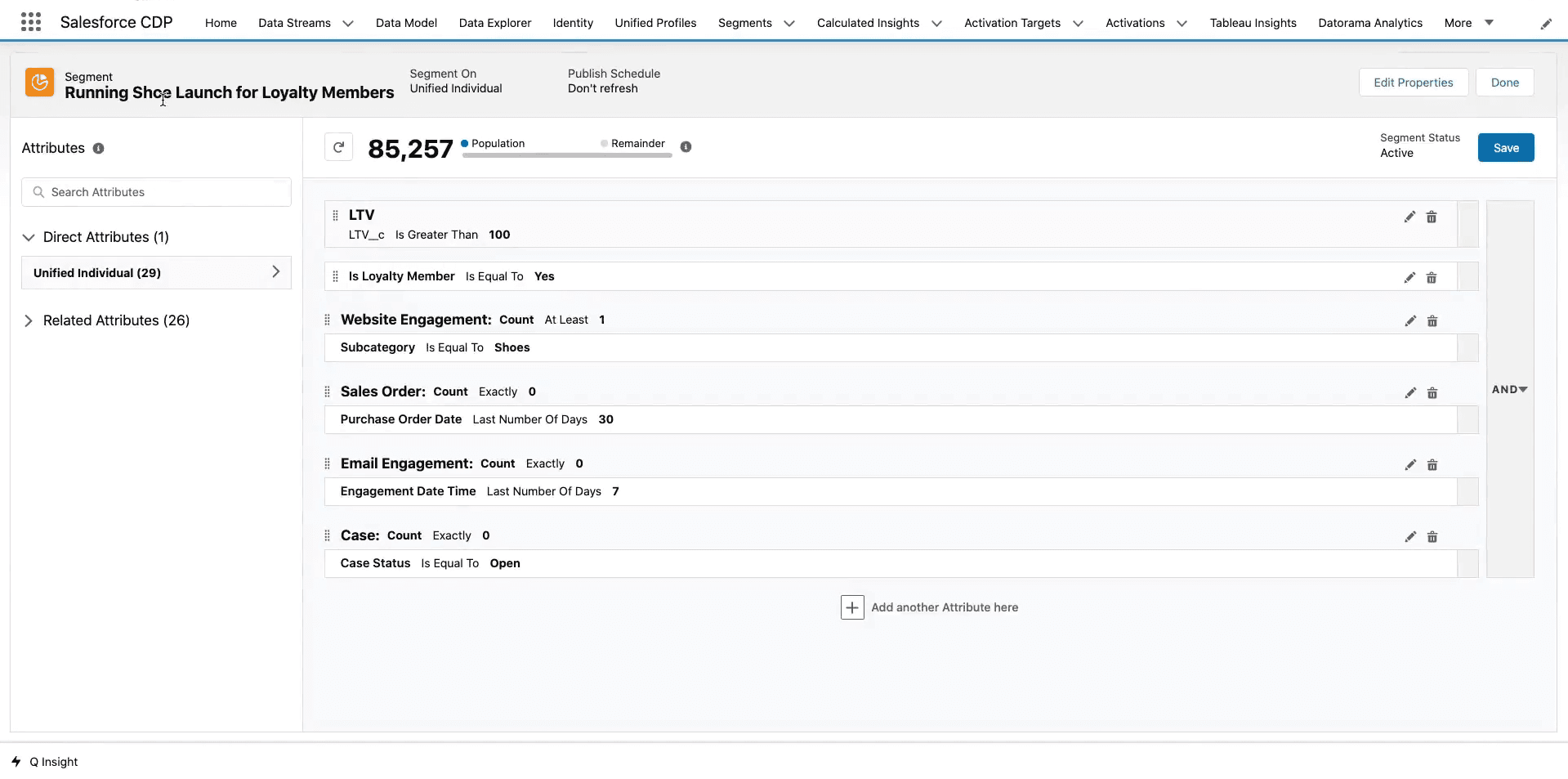
Salesforce Audience Builder
Additionally, these audience cohorts are limited to the data you have available within Salesforce CDP, so any custom data science models or other offline actions that live in your data warehouse will not be natively available within the platform. All audience management within Salesforce CDP is relegated to data from other Salesforce Organizations or other behavioral events you collect through an SDK via your website or mobile app.
Real-time Capabilities
You can view your data streams to see the last 50 refresh operations and any errors that occur to help you troubleshoot potential problems. For web and mobile connectors, user-level data is processed every 15 minutes, and engagement data is processed every two minutes, so it's not exactly real-time. For all other native connectors, you can set your refresh schedule to daily or hourly.

Data Streams
Integrations
It’s surprisingly difficult to move that data out of Salesforce. Because Salesforce CDP is designed to integrate with the existing Salesforce ecosystem, destinations are limited to other Salesforce products like Data Cloud or Marketing Cloud.
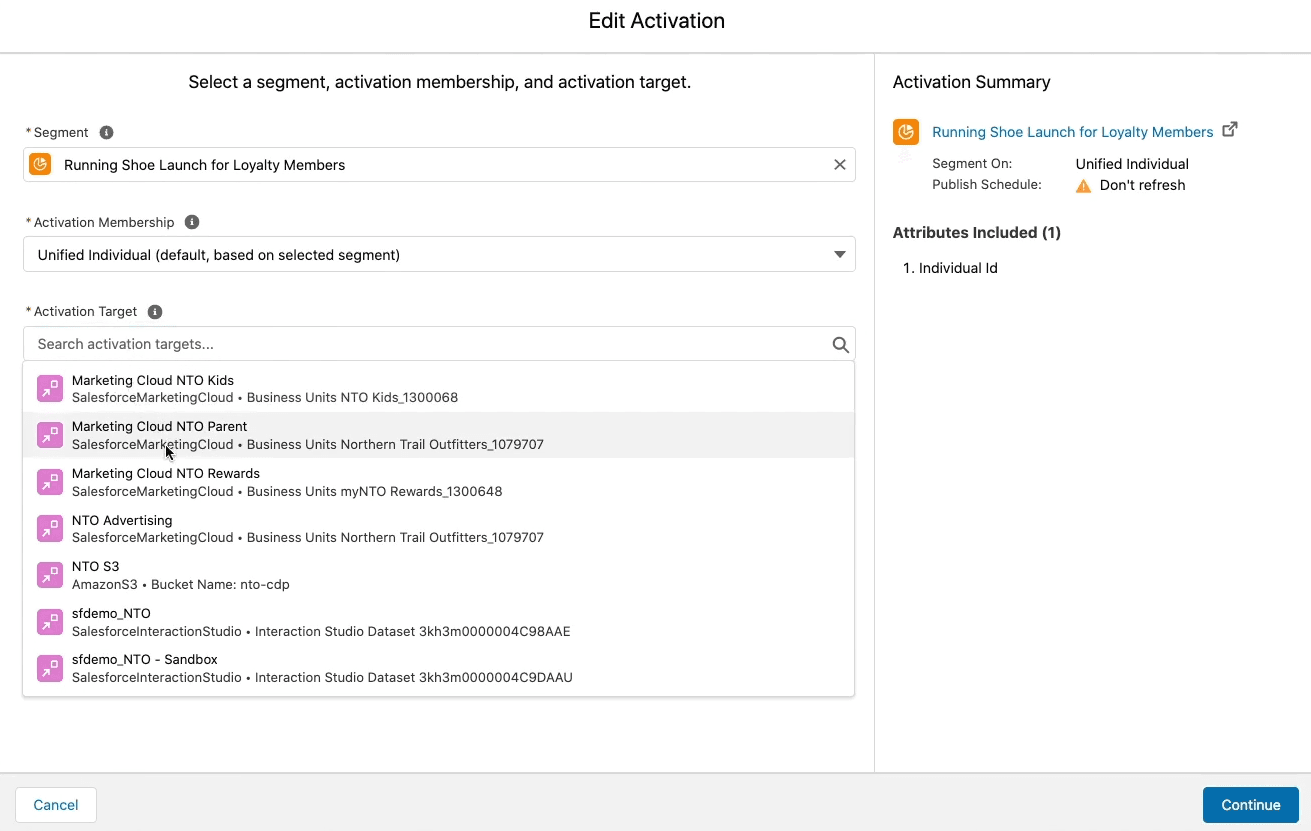
Salesforce Activation Targets
There is some basic support for file storage like S3, SFTP, Google Cloud Storage (GCS), and Azure Blob Storage. However, from an external destination standpoint, the platform can only sync data to Google Ads, Meta, and Amazon Ads. This is one of the main reasons Reverse ETL platforms tend to be much more reliable for syncing data to third-party systems.
Security
Given that Salesforce CDP is mainly a repackaging of existing Salesforce products, the security aspects of the platform are largely the same as you’d see within other Salesforce products. You have access to multi-factor authentication, role-based access controls (RBAC), and other workspace management policies that you can implement to manage your data streams and audiences.
One important factor to keep in mind when it comes to security is that your data is stored in Salesforce infrastructure. From a security standpoint, this makes it more difficult to comply with regulations like GDPR, CCPA, and HIPAA. This is one of the key reasons many companies are adopting Composable CDPs and leveraging their existing infrastructure.
Pricing
Pricing for Salesforce CDP is relatively straightforward. There are three plans: Corporate, Enterprise, and Enterprise Plus.
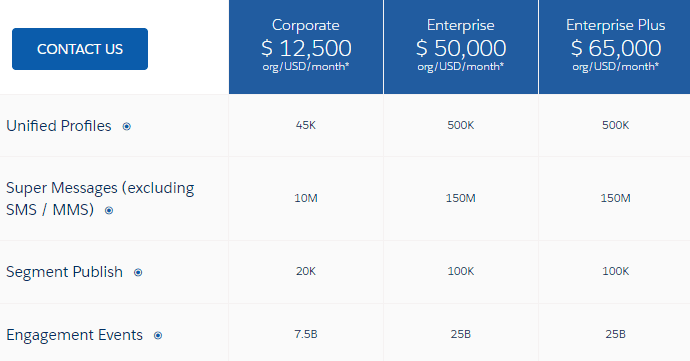
Pricing
- Corporate starts at $12,500 per month
- Enterprise starts at $50,000 per month
- Enterprise Plus starts at $65,000 per month
Pricing is based on four key factors: Unified Profiles, Super Messages, Segment Publish, and Engage Events.
- Unified Profiles: Profiles unified via identity resolution.
- Super Messages: Any personalized message you push to a customer (e.g., SMS, email, push notification, etc.)
- Segment Publish: The total number of segments you can publish to an activation target.
- Engage Events: Records and fields you store from data streams.
There are a ton of add-ons you can add to your Salesforce CDP contract, and most of these are charged on a per-user basis, which means you will quickly increase your costs if you're not careful.
Use Cases
Salesforce CDP consolidates all of your customer data into a single coherent customer profile so that all of your business teams can have access to the same customer data and work towards the same outcomes. Here are a few examples of what this might look like for your business teams:
- Sales: Enriching your sales org with relevant product usage data so your sales reps can see which users and accounts are most active.
- Support: Predicting which customers are at risk of churning so your support team can proactively take action.
- Marketing: Identifying which customers abandoned their shopping cart so your marketing team can follow up with a win-back email encouraging them to finalize their order
- Product: Sending customer attributes to your production database so you can personalize your in-app or on-site experiences and A/B test different messaging variations.
Pros and Cons
Salesforce CDP is actually a very immature product. In many cases, companies only adopt it over other options available in the market because they get buy-in for a new technology or or another vendor. Rather than adopting a CDP solution that will drive business value and solve actual use cases, many companies make the mistake of just buying Salesforce CDP so they can simply say they have a CDP when the reality is that Salesforce CDP is just a repackaging of existing Salesforce features disguised in the form of a CDP. With that in mind, here are some quick pros and cons of the platform.
Pros
- Strong integrations with the Salesforce ecosystem (Marketing Cloud, Service Cloud, CRM, etc.)
- Access to Salesforce partner ecosystem & solutions experts
- Ability to negotiate licenses for free products (Slack, Tableau, etc.)
Cons
- Very expensive (lots of add-on products required)
- Limited integration support for external tools & systems
- Inflexible data data model/schema (cannot support custom objects & entities)
- Long implementation time & difficult setup process
- Data is stored outside of your cloud infrastructure
2024 CDP Landscape Guide
Evaluating CDPs? Download our 2024 CDP Landscape Guide to learn how the top ten enterprise CDPs compare across the following:
- Products & Features
- Core Capabilities
- CDP Type
- Key Differentiator
- Company Direction


Closing Thoughts
Many companies will inevitably adopt Salesforce CDP solely because of their existing footprint within the Salesforce ecosystem. From a data perspective, this will only end in failure because it’s simply impossible for Salesforce to be a single source of truth for all your customer data.
While data warehouses are not perfect, your data warehouse often has the most complete view of your customer because it has access to all of your data–not just information from other Salesforce Organizations. You’re not burdened by the limitations of a third-party vendor, and you have full control over how your data is structured and used.
The easiest and most flexible way to build audiences, perform identity resolution, and activate your customer data to your downstream tools is with a Composable CDP.
If you’re interested in learning more about how you can leverage your existing data infrastructure to drive value immediately, book a demo with one of our solutions engineers to see if you can get started with the Composable CDP. We've also created a CDP RFP template that can help you when you're considering Salesforce as your CDP.










